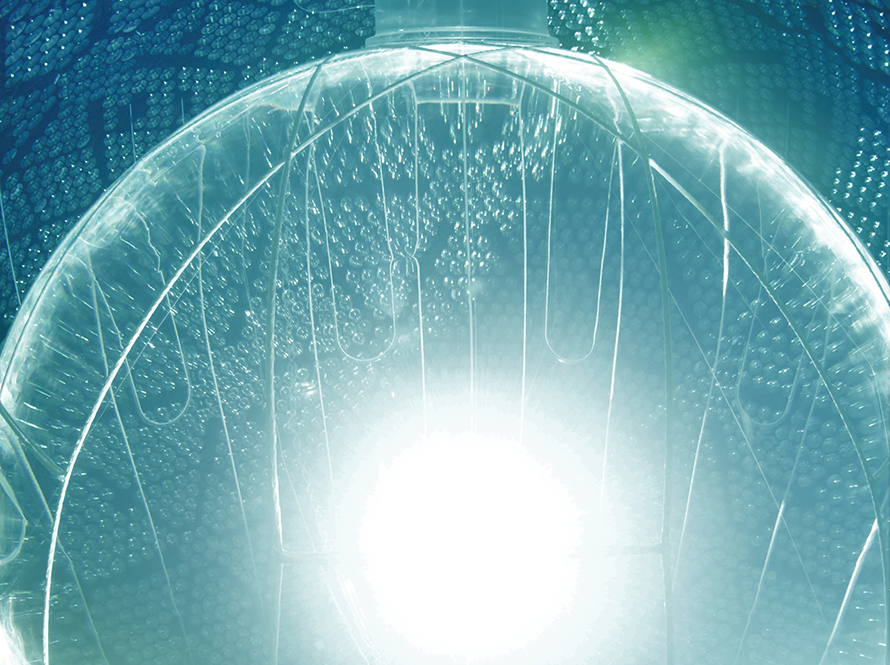
The CheSS experiment is a first step towards the future THEIA experiment. THEIA is a realization of the next generation of optical detectors built under three key concepts: high coverage, new generation of high quantum efficiency and fast photon detector (LAPPD) and water-based liquid scintillator (WBLS). By filling a detector with this unique medium, it will provide the advantages of having scintillation light in a water Cherenkov detector: higher light yield than only Cherenkov, low energy threshold as in a pure scintillation detector, longer attenuation length than a pure scintillation detector, directionality and a powered particle identification by combining Cherenkov and scintillation hypothesis for different particles.
An immediate clear advantage of this new technology is adding the directionality information in a scintillation detector. This is especially interesting in neutrino-less double beta decay experiments (LINK) like SNO+, where the main background is composed by the solar neutrino events and resolving the direction of these events would help to reduce events coming from the sun.

Eos seeks to perform a data-driven demonstration of event reconstruction using both Cherenkov and scintillation signals. To this end, we have built a multi-ton technology demonstrator at Berkeley. The detector is coupled with an array of fast PMTs and the ability to deploy a range of low-energy calibration sources. Results from Eos can influence the development of future large-scale neutrino detectors.

SNO+ is a kilo-tonne scale liquid scintillator neutrino detector. The experiment is located approximately 2km underground in VALE’s Creighton mine near Sudbury, Ontario, Canada. The heart of the SNO+ detector is a 12m diameter acrylic sphere scheduled to be filled with approximately 800 tonnes of liquid scintillator in 2016. The acrylic vessel will be immersed in a water buffer, which functions as shielding from radiation in the surrounding rock. The scintillator volume will be monitored by about 10,000 photomultiplier tubes (PMTs), which are very sensitive light detectors. The acrylic sphere, PMTs and PMT support structure are being re-used from the SNO experiment. Therefore, SNO+ looks almost exactly the same as SNO (shown left) except that, in addition to the ropes that hold the acrylic vessel up, ropes have been added to hold the vessel down once it is filled with (buoyant) scintillator.
Liquid scintillator is an organic liquid that gives off light when charged particles pass through it. SNO+ will detect neutrinos when they interact with electrons in the detector to produce charged particles which, in turn, create light as they pass through the scintillator. The flash of light is then detected by the PMT array, and is converted into information such as energy and position of the particle.

New developments in liquid scintillators, high-efficiency, fast photon detectors, and chromatic photon sorting have opened up the possibility for building a large-scale detector that can discriminate between Cherenkov and scintillation signals. Such a future detector could reconstruct particle direction and species using Cherenkov light while also having the excellent energy resolution and low threshold of a scintillator detector. Situated deep underground, and utilizing new techniques in computing and reconstruction, Theia could achieve unprecedented levels of background rejection, enabling a rich physics program spanning topics in nuclear, high-energy, and astrophysics, and across a dynamic range from hundreds of keV to many GeV. The scientific program would include observations of low- and high-energy solar neutrinos, determination of neutrino mass ordering and measurement of the neutrino CP-violating phase, observations of diffuse supernova neutrinos and neutrinos from a supernova burst, sensitive searches for nucleon decay and, ultimately, a search for neutrinoless double beta decay, with sensitivity reaching the normal ordering regime of neutrino mass phase space.